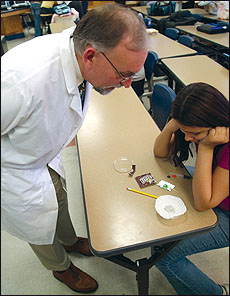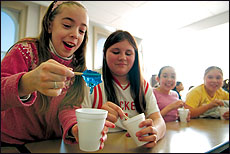Archives
Introducing science to School 19
UB students, faculty reach out to middle-schoolers at after-school program
By MARY COCHRANE
Contributing Editor
The Native American Magnet School, with its three stories of brick walls, stands tall at the intersection of West Delavan and West avenues on Buffalo's West Side. On a chilly April afternoon, a welcome sun shines brightly on an abandoned house across from the school's front entrance, making its broken-glass windows even darker while its green shingles appear as a glaring white, save for the black graffiti messages scrawled below. Nearby, a group of four young men stand defiantly in the middle of the intersection, half-heartedly shoving each other, no traffic to interrupt them.

PHOTOS: DOUGLAS LEVERE
Inside the school, 17 middle-school students are making "slime" in their choice of colors—blue being the most popular—during an after-school program made possible for them by a group of UB professors and students. Their excited voices grow to a loud buzz as their guest instructor-chemistry professor Joseph A. Gardella—shouts over the noise, "Nobody wants to make green slime?" His assistants, two UB graduate students, pour clear liquids and drops of food coloring into each child's plastic cup for mixing.
Many of the students don't know Gardella is a well-known environmental activist and recent recipient of a 2005 Presidential Award for Excellence in Science, Mathematics and Engineering Mentoring, presented to him at the White House by the National Science Foundation in November. A group of girls in the second row have a question, and, uncertain of how to address him, call out "Mister Science Person!"

Chemistry professor Joseph Gardella (top) consults with Raena McIntyre on the results of a color-separation experiment. Monica Ocasio (left) and Tiffany Spruce make "slime" during a recent session of an after-school program conducted by UB students and faculty that is designed to introduce middle school students at the Native American Magnet School to the wonders of science.
Several times, School 19 science teacher Heather Maciejewski has to call for quiet, not because the students are misbehaving but because their animated chatter makes it hard for them to hear the next steps of the experiment. Even with her admonishments, the classroom is never quiet for long. Maciejewski is in good spirits, however, because four sets of parents or relatives have come for this afternoon's "parents day" class.
"That's a lot for this school," Maciejewski said. "We have PTO meetings and only one parent attends."
Maciejewski has taught at the school—officially known as Buffalo's School 19—for seven years, the last two housed at another city school while 19 was completely renovated in a city public schools reconstruction project. Now, the 7th and 8th graders have a state-of-the-art science laboratory in addition to other new classrooms. The K-8 school has 600 students in all; 90 percent of its students are minorities and live at or below the poverty level.
UB "adopted" the school last year after Gardella met Maciejewski when she participated last summer in his Research Institute for Biomedical Materials, Science and Engineering for undergraduates, which studied how drug delivery can assist in tissue engineering and growth.
Rachael D. Brust, a UB junior biochemistry and biophysics major, and one of a dozen or so university students who volunteers at School 19, remembers Maciejewski wanted to transfer what she was learning at the summer program to her students.
"Heather really cares about her students and makes a difference in their education," Brust said. "Many of her students come from troubled backgrounds and don't have the support from home that they need. Many of them have no plans to continue their education after high school—if they graduate from high school at all. Also, middle school is an age when many poor minority students lose interest in science. Our connection with Heather provided a great opportunity to try this outreach."
Alexander N. Cartwright, professor of electrical engineering, said initially he had to perform "a bit of arm-twisting" to convince his students to volunteer in the School 19 program—for which they receive no pay and no academic credit—but now they "just do this on their own."
"I requested my students to become involved, partly because students in middle school will identify better with people who are closer to their age," he said. "They seem to be sincerely interested in introducing science and engineering to the students and really enjoy the time spent there."
Cartwright said he supports the program in part because he identifies with the School 19 students.
"I became involved because I believe that knowledge of science and engineering careers and the people that pursue these fields is essential to bringing kids into science. I grew up in a poor country, the Bahamas, and went to a public school where there were very limited resources—no science was taught. When I was a kid, it was a math teacher who inspired me and made me realize that a math-related career would be possible," he said. "This personal experience makes me very sensitive to the fact that there are many future scientists and engineers in this country—we just need to find them."
The after-school program is the first step in giving the School 19 students confidence that they can pursue these fields, Cartwright added.
"The program provides the middle-schoolers with the opportunity to realize that scientists and engineers are real people—just like them. I think this is much more important than any science that they learn. They see graduate and undergraduate students that are not the 'geeks' that scientists and smart people are portrayed as in movies. I think that they then can go to bed at night and dream that they can be scientists."
Brust said that having college students as program assistants brings the middle-schools closer to the idea that they, too, can pursue careers in science.
"In middle school and high school, you learn a lot about the facts and ideas of scientific principles and systems, but you never learn anything about what it would be like to have a career in science. Your science teacher might be a very intelligent, great person, but they still are seen as a teacher, not a scientist."
Gardella doesn't want to lose the School 19 students either, and hopes to continue the program, despite its lack of formal funding. He said UB "missed the cut by one" on a National Science Foundation grant he applied for last year to fund the program. While he continues to seek other funding sources, he uses his presidential award money to pay for supplies.
Today, these include pizza and pop in honor of parents day, as well as the materials for making the "slime," which Gardella, nearly shouting, tries to tell the students—now talking again—they will use next month for planting seeds to observe how slime's components assist plants as they grow.
But many of the students don't hear him because they are too busy watching another "experiment" by one of the boys, Zachariah Thornton, who is stretching and flattening his slime into an eye mask, which he shows off proudly to his brother, Ernest, and the others. Gardella, smiling, goes off to grab a piece of pizza before it is gone.
